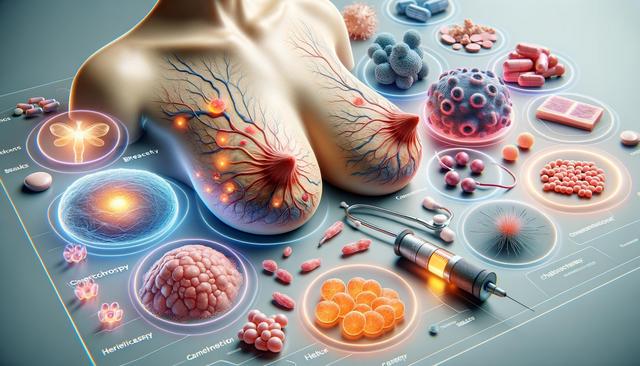What Determines the Right Treatment?
When a person is diagnosed with breast cancer, the treatment plan is shaped by several factors. These include the type and stage of the cancer, its location, and whether it has spread. Additionally, doctors consider the individual’s age, overall health, and personal preferences. Understanding these variables is essential because it helps guide decisions between different treatment paths.
Some breast cancers are hormone receptor-positive or HER2-positive, which can influence the type of medication used. Others may be triple-negative, which limits options to more general approaches like chemotherapy. In many cases, a combination of treatments is recommended to improve outcomes. The goal is to remove or shrink the tumor while minimizing side effects and reducing the risk of recurrence.
Doctors typically work as part of a medical team that includes oncologists, surgeons, radiologists, and other specialists. Together, they develop a personalized treatment plan tailored to the patient’s needs. Regular discussions and follow-ups are crucial to monitor progress and make adjustments if necessary.
Surgery: A Common Starting Point
Surgery is often the first line of treatment for breast cancer. It involves physically removing cancerous tissue from the breast. The two primary types of surgery are:
- Breast-conserving surgery: Also known as a lumpectomy, it removes only the tumor and a small margin of surrounding tissue.
- Mastectomy: This involves removing the entire breast and sometimes nearby lymph nodes.
Which surgical option is chosen depends on the size and location of the tumor, as well as patient preference. In some cases, reconstructive surgery is also offered to restore the breast’s appearance. Recovery times and risks vary, but surgery is generally effective in removing localized cancer.
After surgery, additional treatments such as radiation or chemotherapy may be recommended to eliminate any remaining cancer cells. Follow-up care is essential to monitor healing and reduce the risk of recurrence.
Radiation Therapy: Targeting Cancer Precisely
Radiation therapy uses high-energy rays to destroy cancer cells. It’s frequently used after surgery to kill any cells that may have been left behind. The treatment is carefully planned to focus precisely on the affected area, reducing damage to surrounding healthy tissue.
There are different types of radiation therapy, including:
- External beam radiation: The most common type, delivered from a machine outside the body.
- Brachytherapy: Involves placing a radioactive source directly inside or near the tumor site.
Patients typically receive radiation therapy over several weeks. Each session lasts only a few minutes, but maintaining the schedule is important for its effectiveness. Side effects may include fatigue, skin irritation, and changes in breast texture or color, but these are usually temporary and manageable.
Radiation therapy plays a key role in reducing the chances of cancer returning, especially after breast-conserving surgery. It is often combined with other treatments to increase overall success.
Chemotherapy and Hormone Therapy
Chemotherapy involves using drugs to kill cancer cells or stop their growth. It can be administered intravenously or in pill form and is often used when cancer has spread beyond the breast or if there is a high risk of recurrence. Chemotherapy may be given before surgery (neoadjuvant) to shrink tumors or after surgery (adjuvant) to destroy remaining cells.
Common side effects of chemotherapy include:
- Fatigue
- Nausea and vomiting
- Hair loss
- Increased risk of infection
Though the side effects can be challenging, advances in supportive care have made them more manageable for many patients. Treatment is typically delivered in cycles, with rest periods in between to allow the body to recover.
For hormone receptor-positive breast cancers, hormone therapy can be effective. This treatment blocks the body’s natural hormones, such as estrogen, from fueling cancer growth. Medications may be prescribed for several years after initial treatment to help prevent recurrence. Hormone therapy tends to have fewer immediate side effects than chemotherapy but may cause long-term issues such as bone thinning or hot flashes.
Targeted and Immunotherapy Approaches
Targeted therapy focuses on specific characteristics of cancer cells, such as proteins or genetic mutations that allow tumors to grow. These drugs are designed to interfere with cancer cell function while sparing healthy cells. One example involves attacking the HER2 protein, which is overproduced in some breast cancers.
Immunotherapy, a newer approach, stimulates the body’s immune system to identify and destroy cancer cells. While not yet widely used for all breast cancer types, it holds promise, especially for triple-negative breast cancers. This form of treatment is still under research but is becoming more common in clinical practice.
These advanced treatments are often used in combination with other methods to improve outcomes. Ongoing clinical trials continue to explore their effectiveness and potential side effects.
Patients considering these options should discuss eligibility and benefits with their healthcare provider. Genetic testing may be recommended to determine whether certain targeted therapies might be appropriate.
Conclusion: Making Informed Choices
Understanding breast cancer treatment options empowers patients to make informed decisions. With a range of treatments available—from surgery and radiation to hormone therapy, chemotherapy, and newer approaches like immunotherapy—patients have more tools than ever to manage their health. Personalized treatment plans, guided by a dedicated medical team, ensure that care is tailored to individual needs and conditions. Regular follow-ups and open communication with healthcare providers are essential parts of successful treatment. By staying informed and actively engaged, patients can navigate their treatment journey with greater confidence and support.


